Results 1 to 10 of 28
Thread: Stone ID, please.
Hybrid View
-
05-16-2012, 07:51 PM #1
 Stone ID, please.
Stone ID, please.
I've bought this stone long time ago, when I've received, I've touch it and I was disappointed because was rough like sandpaper 400 grit. Put it in a drawer and never thought it till last day when I've decide to try to lap it for look if was good for my kitchen knifes.
On appearance looks like a piece of marble and I expect it was hard like marble, instead it was very soft and after15 minutes wasrelative flat, but most important, with my big surprise the surface was fine, I would extimate around 8K.
Come from Uk,color is a verylight green with dark green vein.
Couldn't be the rare FIDDISH RIVER honestone from Banffshire, Scotland ?
Thanks
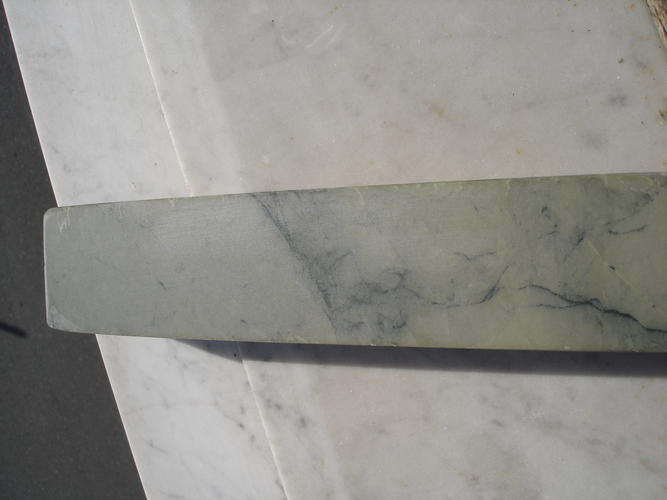
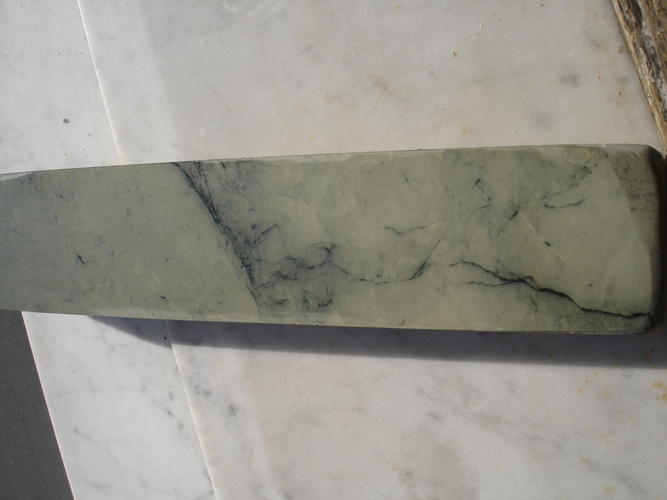
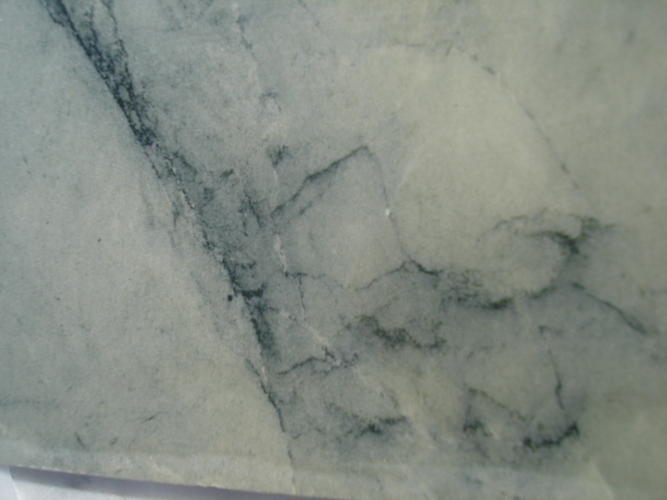
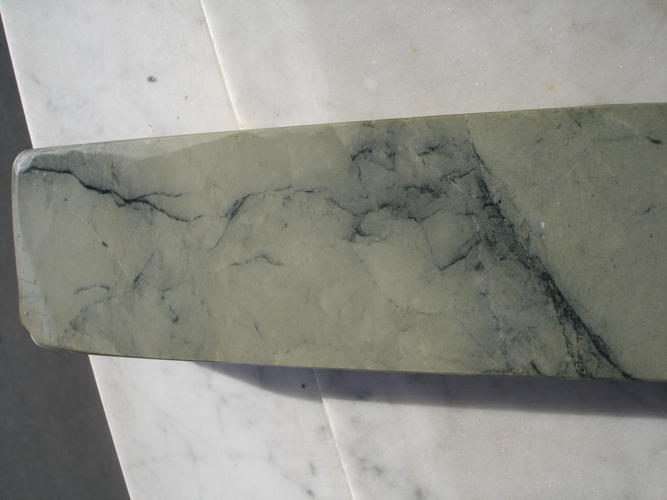
-
05-17-2012, 08:22 AM #2Senior Member

- Join Date
- Mar 2009
- Posts
- 1,211
Thanked: 202
Beautifull hone. Please do not teas me. I have enough trouble running around CFs and Welsh hones.

-
05-17-2012, 09:18 AM #3

I don't think it is an extremely rare stone, more like just rare. It looks like novaculite, if the white lines on the upper side of the first picture are small cracks, like flaking. I don't think UK has nay other novaculite hones accept from Charnely forest and Llyn idwal. Llyn idwal is hard like glass usually, charnley is softer but still hard. Llyn idwal is a bit coarser than Charnley, there are stones near the 8k grit. After that, I'm not sure.
-
05-17-2012, 10:27 AM #4Historically Inquisitive



- Join Date
- Aug 2011
- Location
- Upstate New York
- Posts
- 5,782
- Blog Entries
- 1
Thanked: 4249
Its definately a nice looking stone somewhat like marble but you said its light green could it be a beryl polishing stone?
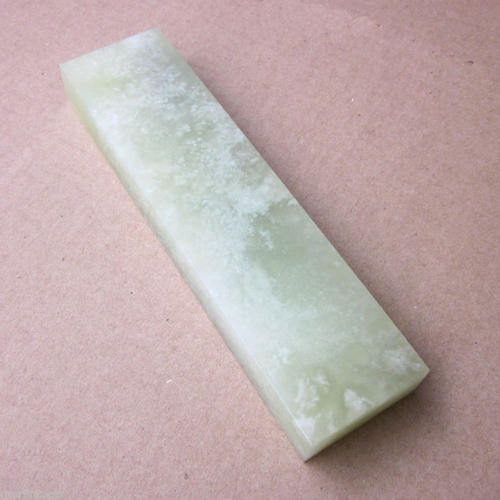
-
05-17-2012, 12:45 PM #5Senior Member

- Join Date
- Mar 2009
- Posts
- 1,211
Thanked: 202
-
05-17-2012, 02:28 PM #6
-
05-17-2012, 03:12 PM #7Senior Member



- Join Date
- Apr 2008
- Location
- Essex, UK
- Posts
- 3,816
Thanked: 3164
Fiddich honestone, eh!
 My one link with the area is Glenfiddich (the river gives it it's name) but I use that more as a lubricant...
My one link with the area is Glenfiddich (the river gives it it's name) but I use that more as a lubricant...
There are a number of quartz and slate quarries there, including one for greywacke that is sometimes found as a long thin honestone with a narrow long paper label stuck to one side. The stuff found in the bed of the Fiddich River is describes as being a laminated marble. Further up is found a black/red layered type of marble which perhaps is of the same sort as that found in the river bed.

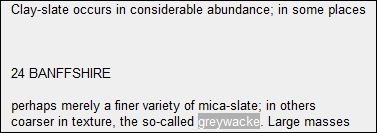
Marble is really a type of limestone that has undergone metamorphic change (ie, it has been subjected to great heat and pressure) and which has become re-crystallised. It may contain all sorts of impurities, but is chiefly calcite so a test is to chip a bit of it off and put it into some hydrochloric acid - it will bubble and fizz. A less aggressive test is to polish the surface, and put a fairly concentrated drop of acid on it (although lemon juice, lime juice, vinegar, etc, will do) - leave it for a while and wipe off: you should see that the acid has dulled the surface (etched it) in the same shape as the droplet.
Marble is fairly soft, hence its use as a moulding material and for sculpture. It is nowhere as hard as granite or novaculite and some of it has a visible blend of large and small grains, some of which may be harder than others, making it unsuitable as hone if these 'scratchy' grains are present. It's hardness rating is sometimes quoted as from 2.5 to 5 on the MOHS scale of hardness. AS pure calcite is rated at 3 then maybe 4 is a fair average that would encompass a fair few varieties of marble. That puts us more in the same range as gold, plain iron and platinum and very, very soft steel. A good quality razor steel would probably rate at between 5.5 and 6.5.
To put that in context, belgian coticules rely on garnet grains in their matrix to do the cutting, and garnet is around 6.5 on the MOHS scale, which is close to novaculite. Granite is chiefly composed of quartz (along with an immensely variable amount of other minerals), and quartz is 7 on the scale. Beryl is harder still - 7.5 to 8.0.
So - if you found it easier to lap than marble then clearly it is not a form of novaculite or beryl.
Also, coming from the UK is no guarantee that it is found naturally occurring in the UK - the UK has always imported a vast amount of figurative stones. A lot of these stones found uses as ornamental plinths, slabs in old-fashioned larders and large slabs adorning the walls of buildings. A lot of them are in UK scrapyards - and there is a current trend that has become evident lately in the UK of persons cutting any promising looking slabs found in scrapyards into hone-stone sizes and selling them as such. If they work - fine. If they don't - you have been 'had'.
Well that's the easy part out of the way - finding what it isn't!
It does look remarkably like a few other specimens I have seen lately - I think one was shown wet on this site and looked very striking, a beautiful stone. I think I even have something similar myself somewhere, but I have no idea what it is.
Regards,
NeilLast edited by Neil Miller; 05-17-2012 at 03:19 PM.
-
The Following 2 Users Say Thank You to Neil Miller For This Useful Post:
Bushdoctor (05-17-2012), Johnus (05-20-2012)
-
05-17-2012, 03:30 PM #8

The LIs have a wide range of hardness and fineness. I've had Grecian like LIs that were as coarse as 8-9k maybe and I assume softer than any CF. But I also have dark green LIs that seem much harder than any CFs I tried. I have one LI (or at least I think it is) that is finer than all the CFs I've tried. I also had one small LI with a speckled stripe pattern that was as fine.
They are natural stones and we each have different stones we compare so our outcomes are going to differ as well.


 15Likes
15Likes LinkBack URL
LinkBack URL About LinkBacks
About LinkBacks






 Reply With Quote
Reply With Quote
